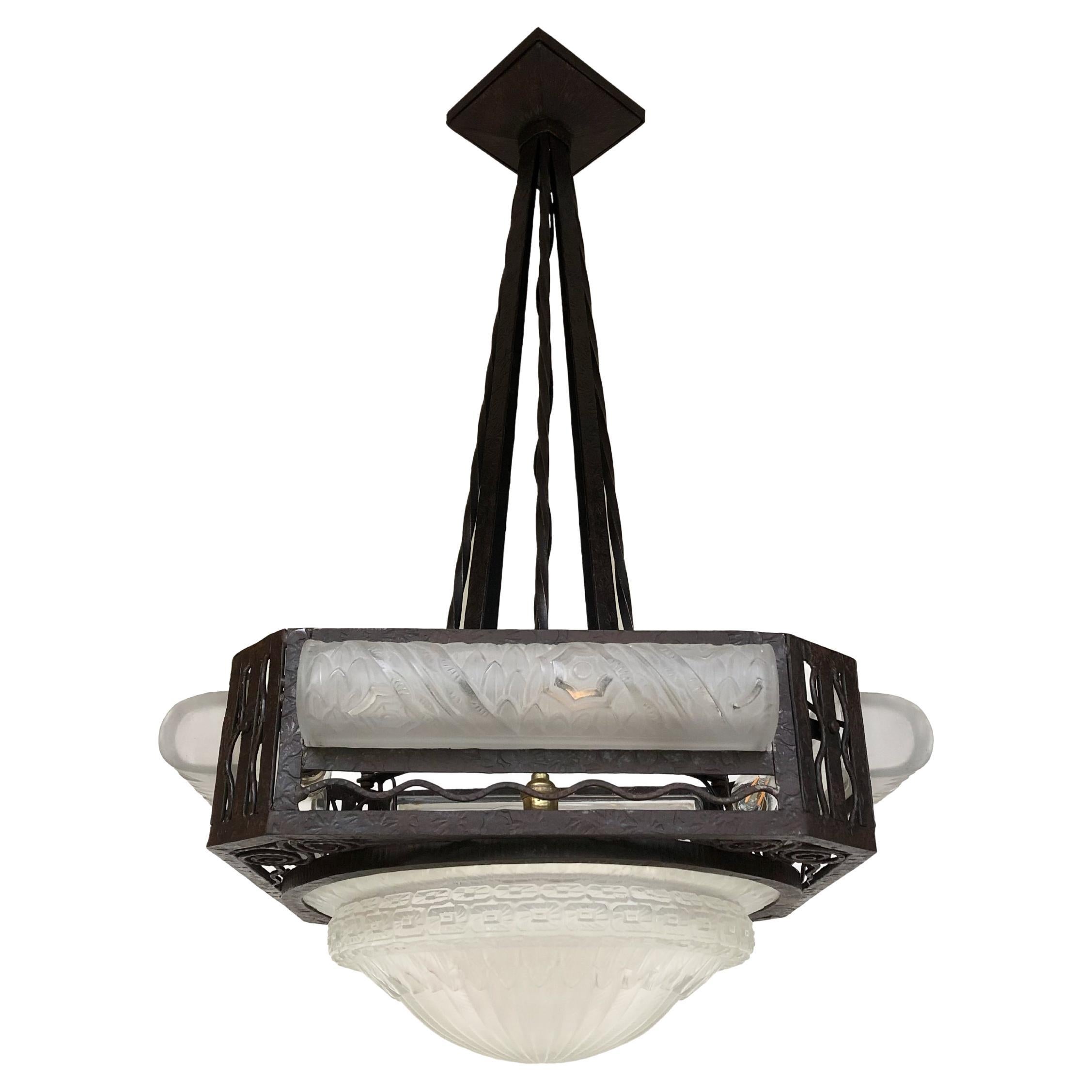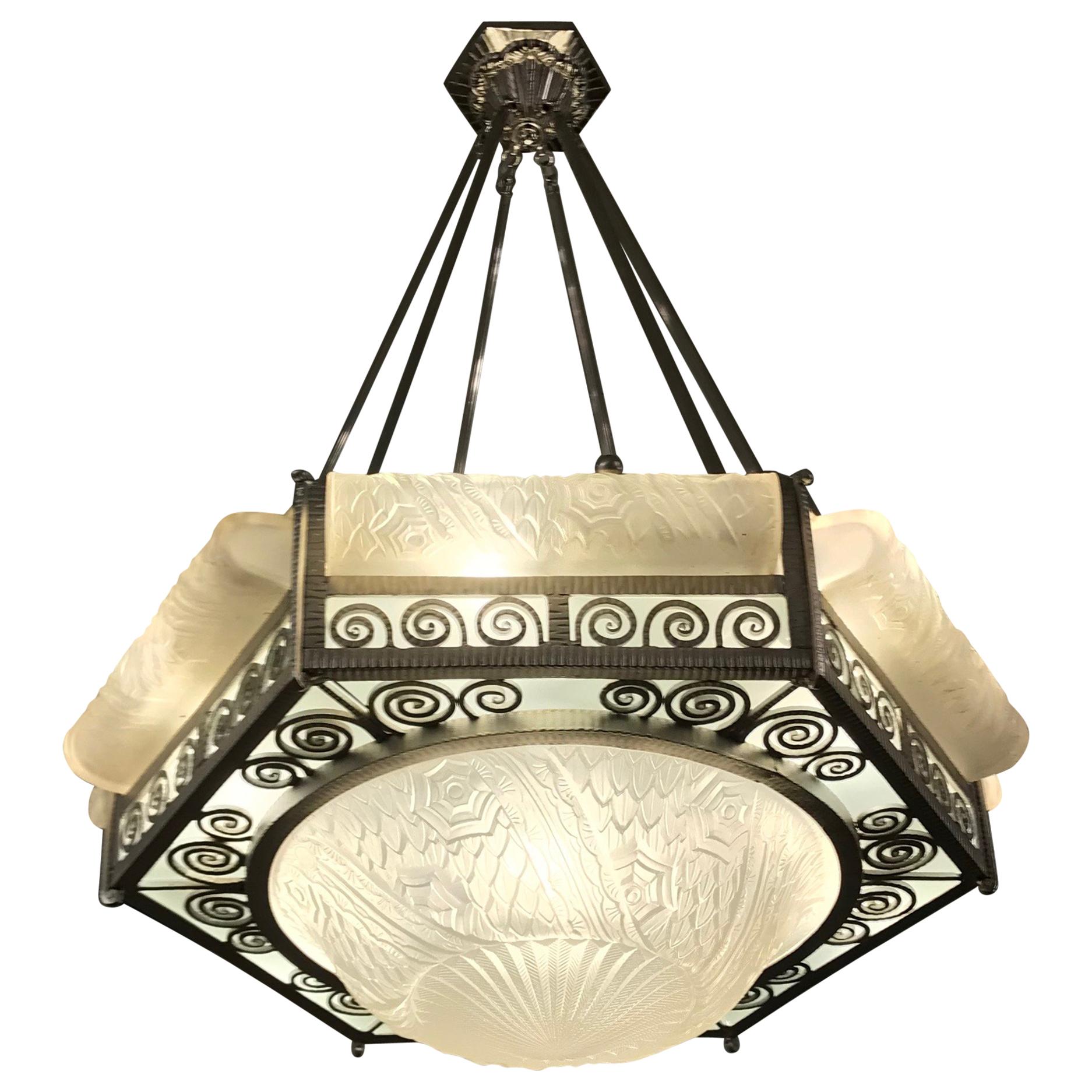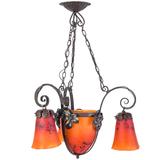French Schneider Art Deco Chandelier
About the Item
- Creator:Charles Schneider (Maker)
- Dimensions:Height: 37 in (93.98 cm)Width: 22 in (55.88 cm)Depth: 22 in (55.88 cm)
- Style:Art Deco (Of the Period)
- Materials and Techniques:
- Place of Origin:
- Period:
- Date of Manufacture:1925
- Condition:Wear consistent with age and use. Near Mint. One small hairline crack on one of the large bowls, but not significant or visible.
- Seller Location:Dallas, TX
- Reference Number:1stDibs: LU3978118144042
Charles Schneider
The Schneider Glassworks (Verreries Schneider), established by brothers Charles and Ernest Schneider in Epinay-sur-Seine, France, in 1917, was among the leading producers of fine-art glass between the two world wars, creating exuberantly colorful vessels and lighting fixtures in both the Art Nouveau and Art Deco styles. The factory’s highpoint was the 1920s, when it created iconic chandeliers and exquisitely decorated cameo glass vases that are still in high demand today.
Born in the last quarter of the 19th century in Château-Thierry, near Paris, Charles and Ernest Schneider moved with their family at a young age to Nancy, a major center of Art Nouveau design, particularly known for glass. Among the city’s master makers was the crystal studio Daum, where both brothers worked at the turn of the 20th century, Ernest in sales, and Charles receiving training in the engraving and decoration workshop, while concurrently learning drawing and modeling with Henri Bergé and attending the École des Beaux-Arts in Nancy. In 1904, he enrolled at the École Nationale Supérieure des Beaux-Arts, in Paris, where he studied painting and metal engraving and regularly showed in the engraving section of the Salon de la Société des Artistes Français, twice receiving a prize.
Around 1912 the brothers and their friend, architect Henri Wolf, bought a small glass factory specializing in lightbulbs, renaming it Schneider Frères et Wolff. The partners enticed a group of about 20 workers from the Daum workshop to join the company, which produced high-quality cameo vases and lamps until the outbreak of World War I, in 1914, when Charles, Ernest and most of the workers were called up to fight. The Schneiders were demobbed in 1917 and reopened the factory, initially making practical glassware for hospitals. After the war, to fund their reentry into the art-glass market, they sold shares in the company, now named the Société Anonyme des Verreries Schneider. The success of the elegant drinking glasses and Art Nouveau-style cameo vases they produced allowed the brothers to buy back the shares, at which point they renamed the factory Verreries Schneider.
When a fire destroyed the Gallé studios in 1918, the Schneiders offered space to a group of the company’s artists so they could continue production. In return, they taught Charles marqueterie de verre. Similar to wood marquetry, this process involves cutting sections out of a glass surface and filling them with pieces of a contrasting color. In 1921, Schneider trademarked his technique for making cameo glass lamps and vases — exemplified in this piece from the early 1920s — which he signed “Le Verre Français” or “Charder,” the latter perhaps a portmanteau combining his first and last names. These works were popular and sold well at France’s top department stores, including Galeries Lafayette and Le Bon Marché. More elaborate, one-of-a-kind pieces from the studio were signed “Schneider” and offered at Paris art galleries like Au Vase Etrusque and Delvaux.
The Schneiders participated in the 1925 Exposition Internationale des Arts Décoratifs et Industriels Moderne in Paris, at which Charles was a member of the jury. The company was at its peak, expanding both its design repertoire and the number of workers, to 500. During this period, it began moving away from the organic shapes of Art Nouveau to the more geometric designs of Art Deco, with some pieces embodying a kind of transitional style, such as this chandelier. Charles also began experimenting with pigmented powders, fine crushed glass mixed with metal oxides, which yielded brilliant, iridescent colors when applied to a glass surface.
A large portion of the factory’s art glass production was sold in the United States. When the U.S. stock market crashed in 1929, demand was all but obliterated, and the company struggled to stay afloat throughout the 1930s. Ernest died in 1937, and during World War II, the factory was seized by German troops and used as a canteen. In 1950, Charles and his son set up a new factory called Cristalleries Schneider in Epinay-sur-Seine, which for several years produced free-blown glass vases, small sculptures and lighting fixtures to some acclaim. Charles Schneider died in 1952, and the factory eventually closed in 1981.
- ShippingRetrieving quote...Ships From: Dallas, TX
- Return PolicyA return for this item may be initiated within 7 days of delivery.
- Monumental Midcentury Art Deco Style Ballroom Chandelier with ProvenanceLocated in Dallas, TXWe have the distinct pleasure to present to you a selection of Monumental midcentury Art Deco style Ballroom c...Category
Mid-20th Century American Art Deco Chandeliers and Pendants
MaterialsCrystal, Brass
- Monumental Midcentury Art Deco Style Ballroom Chandelier with ProvenanceLocated in Dallas, TXWe have the distinct pleasure to present to you a selection of monumental midcentury Art Deco style ballroom c...Category
Mid-20th Century American Art Deco Chandeliers and Pendants
MaterialsCrystal, Brass
- 19C French Gilt Bronze 18 Branch ChandelierLocated in Dallas, TXPresenting a beautiful 19C French gilt bronze 18 branch chandelier. Made in France circa 1880/90. 18 Branches and 18 bulbs. Rococo Revival (Third Republic) heavily influence...Category
Antique Late 19th Century French Rococo Revival Chandeliers and Pendants
MaterialsBronze, Ormolu
- 19th Century Large French Ormolu and Alabaster ChandelierLocated in Dallas, TXAbsolutely gorgeous 19th century French chandelier in the Louis XVI style. Ormolu and brass central columns and supports. Central column surrounded by three laurel wreaths. Three s...Category
Antique Late 19th Century French Louis XVI Chandeliers and Pendants
MaterialsAlabaster, Ormolu
- 19C French Gilt Metal 12 Light Phoenix Chandelier with Swarovski CrystalLocated in Dallas, TXPresenting a stunning 19C French gilt metal 12 light phoenix chandelier with Swarovski crystal. This chandelier pre-dates the advent of electricity and originally would have held candles. Made in France circa 1860 it was converted to electrical use in the early 20th Century, circa 1920. We can deduce this from the holes that were drilled into the piece to convert it and to install the wiring. Very ‘Rococo’ in style it has 4 branches, each holding 3 lights (12 in total). The branches are scrolling and flowing vine leaves. The light sockets have tulip like holders which sit on and a large starburst shaped flower. The base section ends in a downward pointing flower. The central and top sections again have scrolling vine leaves, separated by a large starburst shaped flower. The crown is a large starburst shaped flower/leaf. What makes this chandelier truly unique are the 4 ‘Phoenix’ birds around the top of the light section, each with a flower petal underneath. They are unmistakeably ‘Phoenix’ birds ! The chandelier has approximately 50+ large Swarovski Crystal faceted pendant drops. We still get a ‘chuckle’ from the fact that this stunningly rare chandelier features the ‘Phoenix”. We acquired it from a high-end estate here in Dallas from a Mansion built in 1929. When we acquired it, it was in pieces, albeit the pieces were all there in a large box (save the crystal). All the wiring was gone and one branch was broken. We repaired the broken branch, re-wired it, re-assembled it and used gorgeous 1960’s Swarovski crystals to replace the missing originals ….. only then did we notice the birds ….. TRULY … ‘The Rise of the Phoenix from the Ashes’ !!!! LOL The crystal alone on this, is worth over $2k. The phoenix is an immortal bird associated with Greek mythology (with analogs in many cultures) that cyclically regenerates or is otherwise born again. Associated with the sun, a phoenix obtains new life by rising from the ashes of its predecessor. Some legends say it dies in a show of flames and combustion, others that it simply dies and decomposes before being born again. In the Motif-Index of Folk-Literature, a tool used by folklorists, the phoenix is classified as motif B32. The origin of the phoenix has been attributed to Ancient Egypt by Herodotus and later 19th-century scholars, but other scholars think the Egyptian texts may have been influenced by classical folklore. Over time the phoenix motif spread and gained a variety of new associations; Herodotus, Lucan, Pliny the Elder, Pope Clement I, Lactantius, Ovid, and Isidore of Seville are among those who have contributed to the retelling and transmission of the phoenix motif. Over time, extending beyond its origins, the phoenix could variously “symbolize renewal in general as well as the sun, time, the Empire, metempsychosis, consecration, resurrection, life in the heavenly Paradise, Christ, Mary, virginity, the exceptional man, and certain aspects of Christian life”. Some scholars have claimed that the poem De ave phoenice may present the mythological phoenix motif as a symbol of Christ’s resurrection...Category
Antique Mid-19th Century French Rococo Chandeliers and Pendants
MaterialsCrystal, Metal, Ormolu
- 19C Dutch Baroque Style Antique Brass 6 Branch ChandelierLocated in Dallas, TXPRESENTING A GORGEOUS 19C Dutch Baroque Style Antique Brass 6 Branch Chandelier. Late 19th Century, circa 1880-90 and made in Holland (Netherlands) from antique brass which gives it a more bronze...Category
Antique 19th Century Dutch Baroque Revival Chandeliers and Pendants
MaterialsBrass
- French Art Deco Chandelier by SchneiderBy Charles SchneiderLocated in Long Island City, NYSpectacular grand scale French Art Deco chandelier was created by the French Artist " Schneider " The lower tier is in a hexagon shaped nickel bronze frame, embracing six horizontal ...Category
Mid-20th Century French Art Deco Chandeliers and Pendants
MaterialsBronze
- Schneider Art Deco ChandelierBy Charles SchneiderLocated in NANTES, FRChandelier Charles Schneider square frame in wrought iron with 5 molded glass pieces all signed. In perfect condition and electrified. 5 led bulbs. Possibility of reducing the he...Category
Early 20th Century French Art Deco Chandeliers and Pendants
MaterialsWrought Iron
- French Art Deco Hexagonal Chandelier by SchneiderBy Charles SchneiderLocated in North Bergen, NJGrand French Art Deco chandelier by the French Artist Charles Schneider. With a hexagon shaped nickel bronze frame, embracing six horizontal oblong glass shades with matching central coupe. The glass shades are in clear frosted with polish details having floral and geometric motif throughout. The chandelier has been re plated in polished nickel and re wired for U.S. standards. Having seven candelabra...Category
Early 20th Century Art Deco Chandeliers and Pendants
MaterialsGlass
- French Art Deco Pendant Chandelier by SchneiderBy Charles SchneiderLocated in North Bergen, NJA French Art Deco pendant designed by the French artist “Schneider“. Clear frosted molded glass shade with intricate flowers and geometric polished motif details held by three rods w...Category
Early 20th Century Art Deco Chandeliers and Pendants
- French Art Deco Chandelier by Charles SchneiderBy Charles SchneiderLocated in Kingston, NYThis magnificent early French Art Deco chandelier was designed and signed by Charles Schneider. It features a hand-wrought iron base with floral design and beautiful crimson glass...Category
Vintage 1920s Art Deco Chandeliers and Pendants
MaterialsWrought Iron
- Art Deco Chandelier by SchneiderBy Charles SchneiderLocated in Bridgewater, CTA French Art Deco chandelier by Schneider in gilded bronze and motteled glass from circa 1925.Category
Vintage 1920s French Art Deco Chandeliers and Pendants
MaterialsBronze






